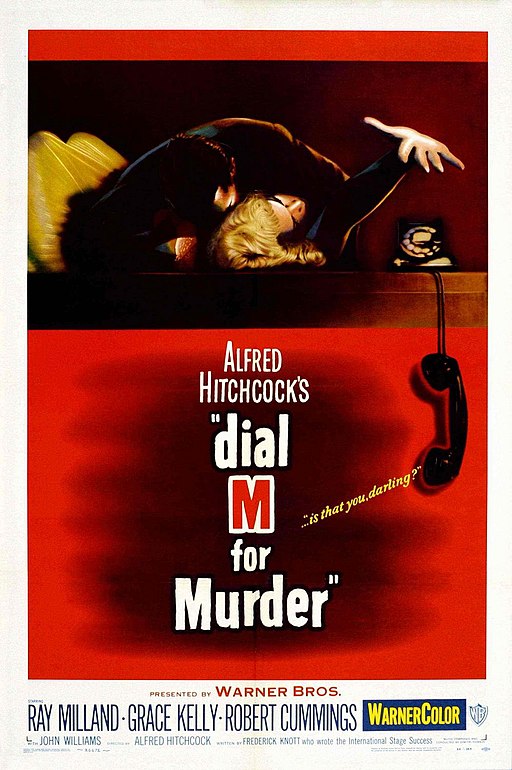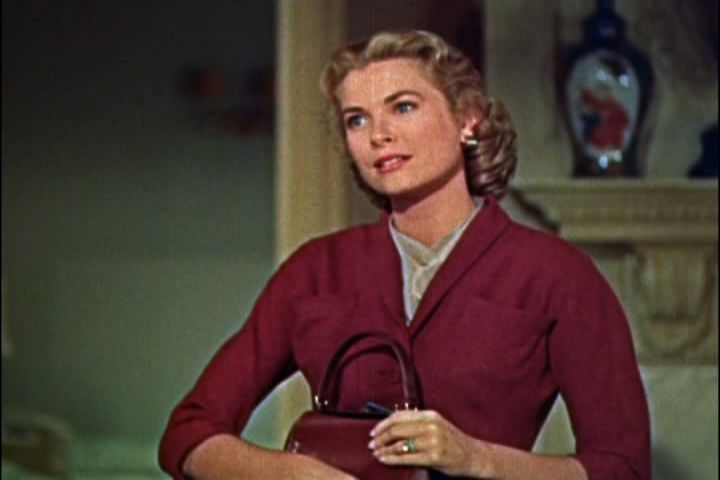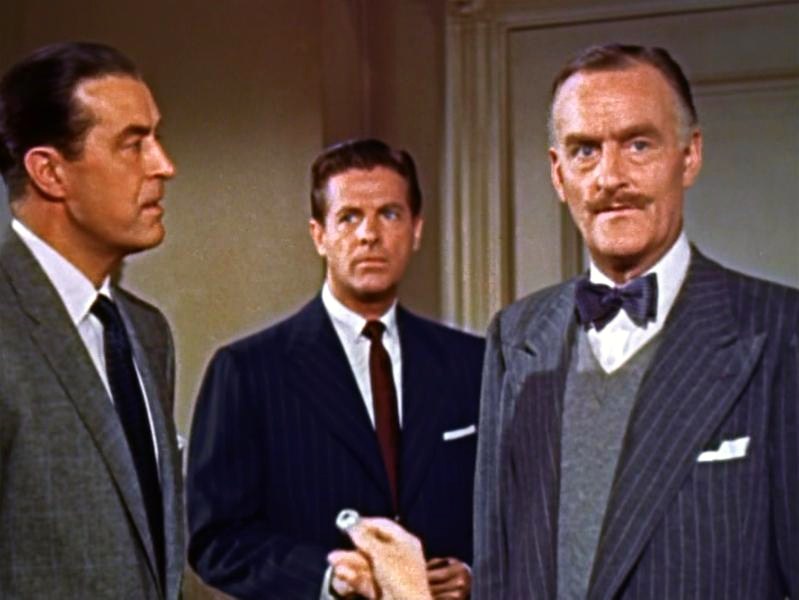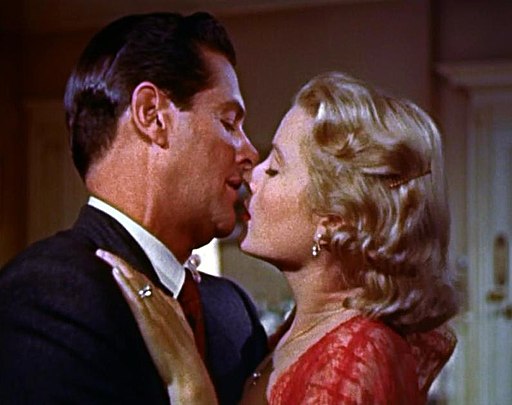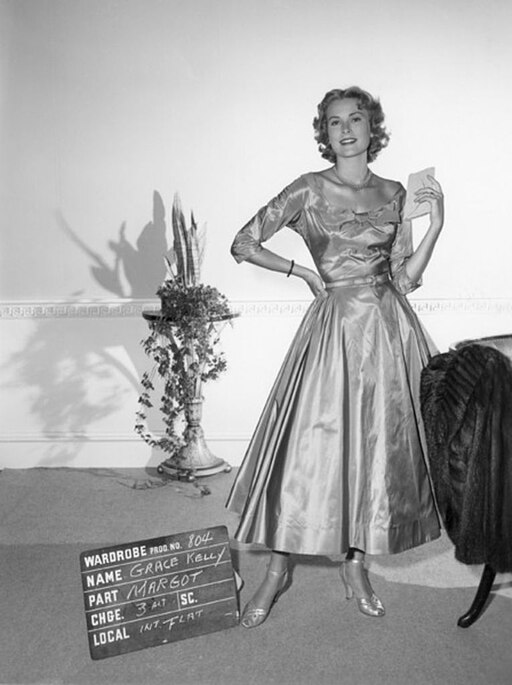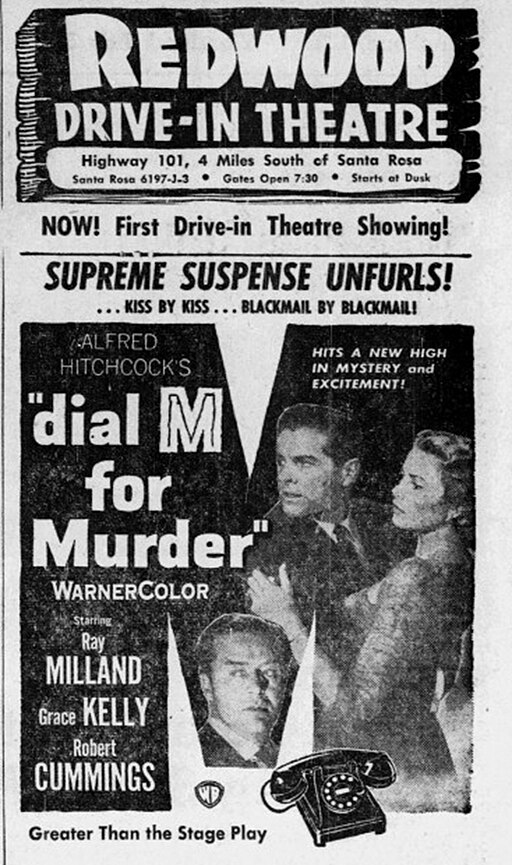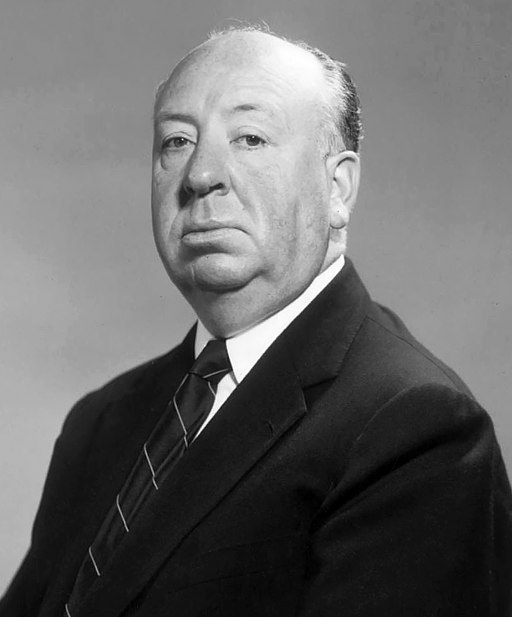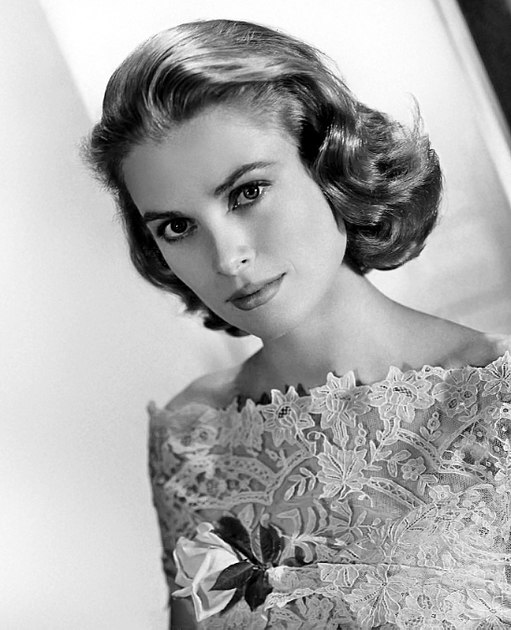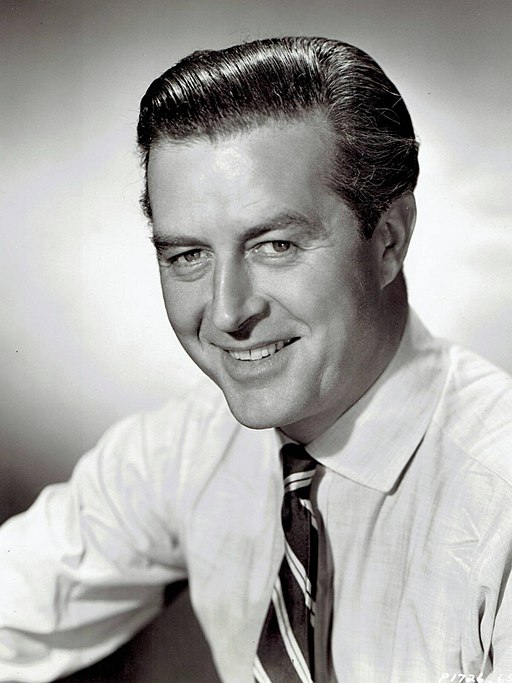Dial M for Murder - 1954
back| Released by | Warner Bros. |
| Director | Alfred Hitchcock |
| Producer | Alfred Hitchcock |
| Script | Frederick Knott (based on his play) |
| Cinematography | Robert Burks |
| Music by | Dimitri Tiomkin |
| Running time | 105 minutes |
| Film budget | $1.4 million |
| Box office sales | $2.7 million |
| Main cast | Ray Milland - Grace Kelly - Robert Cummings - John Williams |
Dial M for Murder – 1954
A domestic chess game of deceit and murder
"Dial M for Murder" is a suspenseful tale that Alfred Hitchcock adapted from Frederick Knott's stage play. The story revolves around Tony Wendice, a former tennis pro played by Ray Milland, who plots to murder his wealthy wife Margot, portrayed by Grace Kelly, for her money and because she has been unfaithful. When his elaborate plan goes awry, he quickly improvises to frame Margot for the murder of her assailant.
Hitchcock's direction creates a claustrophobic atmosphere, with the majority of the film confined to the Wendices' apartment, enhancing the tension and focus on the characters' interactions. Initially released with mixed reviews, the film has since been reappraised for its meticulous plotting, the director's use of 3D cinematography to heighten the suspense, and its clever narrative structure.
Its impact is significant in its representation of the perfect crime motif and its influence on the thriller genre, showcasing Hitchcock's ability to evoke suspense from a singular location. "Dial M for Murder" also fortified Grace Kelly's status as a leading lady and Hitchcock muse. It remains a classic for its tight script, strong performances, and Hitchcock's distinctive touch, which keeps audiences entangled in its web of deceit and danger.
Related
Dial M for Murder
Complete overview, analysis and full cast
"Dial M for Murder" is a quintessential Hitchcockian blend of suspense, drama, and a touch of dark humor, a film that emphasizes the director's fascination with the perfect crime. Set in a cozy London flat, the movie revolves around the lives of Tony Wendice, a former tennis pro, and his wealthy wife, Margot, played with elegance by Grace Kelly. When Tony discovers Margot's affair with American crime-fiction writer Mark Halliday, his jealousy spawns a calculated plot to murder her.
Tony’s scheme, however, is far from foolproof. When the plan goes terribly wrong, he must improvise a web of deceit to frame Margot for premeditated murder. The narrative then shifts into a gripping psychological game of cat and mouse. Hitchcock deftly utilizes the confined space of the Wendices' apartment to create an atmosphere brimming with tension, allowing the camera to become a silent participant in the unfolding plot.
What stands out in "Dial M for Murder" is not just the tension, but also the meticulous attention to detail. Hitchcock's direction is a lesson in precision and timing, employing his unique ability to build suspense from the simplest of dialogues and actions. Coupled with Frederick Knott’s crisp dialogue, the film delves into the intricacies of betrayal, guilt, and retribution.
The performances are top-notch, with Ray Milland's portrayal of the suave yet sinister husband, and Grace Kelly’s transition from the adulterous spouse to a terrified victim. John Williams delivers a standout performance as Chief Inspector Hubbard, whose methodical approach and keen observation are key to unraveling the plot.
Robert Burks’ cinematography, with its strategic use of angles and lighting, enhances the claustrophobic sensation of the narrative, while Dimitri Tiomkin's score underscores the suspense. The film, which was originally shot in 3D, demonstrates Hitchcock’s interest in the technical aspects of filmmaking, though the 3D elements are subtle and serve more to intensify the drama rather than act as a gimmick.
Despite not being initially heralded as one of Hitchcock’s finest upon release, "Dial M for Murder" has since been appreciated for its elegant craft and has become a staple in the Hitchcock canon. It is often referenced for its crafty plot structure and its pivotal role in the suspense genre. The box office success, coupled with the film’s enduring appeal to audiences and critics alike, cements "Dial M for Murder" as a classic that stands testament to Hitchcock’s title as the ‘Master of Suspense.’
Analysis of “Dial M for Murder”:
Narrative Structure
The narrative of "Dial M for Murder" is linear, with most of the plot unfolding within the Wendices' apartment, adding to the claustrophobia and tension. The simplicity of the setting contrasts sharply with the complexity of the murder plot, creating an intimate yet suspenseful atmosphere.
Themes
The film delves into themes of infidelity, greed, and the concept of the "perfect crime." It dissects the idea that even the most meticulously planned crimes can unravel in the face of human error and unforeseen circumstances.
Characterization
Tony Wendice, portrayed by Ray Milland, is a compelling antagonist, whose charming exterior masks a cold and calculating mind. His transition from a loving husband to a conniving mastermind is both chilling and fascinating. Grace Kelly's Margot Wendice is the sympathetic victim, whose affair makes her vulnerable to her husband's deadly scheming. The interplay between the characters, including Mark Halliday and Inspector Hubbard, reveals a dynamic and suspenseful human chess game.
Direction
Hitchcock's direction is a critical element, with his trademark touches evident throughout. The use of close-ups, POV shots, and meticulous framing creates a voyeuristic feel. The audience is privy to Tony's plans, creating dramatic irony that heightens the suspense — we know more than the characters on screen, which makes the unfolding drama more compelling.
Cinematography
Robert Burks’ cinematography complements Hitchcock’s vision perfectly. The careful use of color and lighting adds depth to the film, and the subtle use of 3D technology, unusual for its time, enhances certain scenes without overpowering the storytelling.
Performance
The performances are stellar. Milland's nuanced portrayal of Tony Wendice is matched by Kelly's depiction of a woman caught in a web of lies. John Williams as Inspector Hubbard provides a steady and intellectual counterpoint to Tony's manipulations.
Screenplay
The screenplay, adapted by Frederick Knott from his own play, is tight and focused, allowing the characters' psychological complexity to shine through. The dialogue is sharp and loaded with subtext, revealing the characters' true motives and feelings.
Score
Dimitri Tiomkin's score subtly underscores the tension, punctuating key moments and heightening the emotional impact of the film.
Impact and Legacy
Though not initially considered among Hitchcock's greatest works, "Dial M for Murder" has grown in stature over time. Its influence can be seen in countless thrillers that followed, with many films paying homage to its style and storytelling techniques.
In summary, "Dial M for Murder" is a masterclass in suspense, showcasing Hitchcock's skill at manipulating audience emotions and expectations. The film's ability to remain thrilling and engaging, despite a single location and a simple premise, is a testament to the director's genius and the potent combination of performance, writing, and technical craftsmanship.
Full Cast of “Dial M for Murder”:
- Ray Milland as Tony Wendice
- Grace Kelly as Margot Mary Wendice
- Robert Cummings as Mark Halliday
- John Williams as Chief Inspector Hubbard
- Anthony Dawson as Charles Alexander Swann aka Captain Lesgate
- Leo Britt as the Storyteller
- Patrick Allen as Detective Pearson
- George Leigh as Detective Williams
- George Alderson as First Detective
- Robin Hughes as Police Sergeant O'Brien
Analysis of the direction of Alfred Hitchcock:
Alfred Hitchcock's direction of "Dial M for Murder" showcases his masterful control of suspense and his penchant for meticulous craftsmanship. This film, adapted from a stage play, is particularly noted for its effective use of confined space, essentially taking place in one room. Hitchcock makes this single setting far from static or dull; through his innovative use of camera angles and movements, he creates a dynamic and claustrophobic atmosphere that accentuates the dramatic tension.
One of Hitchcock's trademarks is his ability to manipulate the audience's emotions, and in "Dial M for Murder," he does this by aligning viewers closely with the characters' perspectives. For instance, he uses tight close-ups to capture the actors' nuanced performances, particularly those of Grace Kelly, allowing the audience to engage directly with their emotions and thoughts.
Moreover, Hitchcock's use of 3D technology in the film was ahead of its time, despite being less known for it. He utilized the technology not for gimmicks but to enhance the depth of the setting, making the viewer feel like an additional character within the room where the suspense unfolds.
His direction is also evident in the pacing of the film. Hitchcock builds tension slowly, starting with a deceptively calm setup and escalating to a tight, thrilling climax. He meticulously orchestrates the plot twists and character revelations, ensuring that the suspense remains high until the final resolution.
Analysis of the performance of Ray Milland:
Ray Milland's portrayal of Tony Wendice in Alfred Hitchcock's "Dial M for Murder" is a testament to his ability to embody a character with a chillingly methodical and cold-blooded nature. His performance is pivotal to the film's success, as he plays the role of a retired tennis player who meticulously plans the perfect murder of his wealthy wife, played by Grace Kelly, in order to inherit her fortune.
Milland's Tony Wendice is not the typical Hitchcock villain who might exude overt menace or instability. Instead, he is suave, charming, and outwardly affectionate, traits that serve to disguise his sinister intentions. Milland brings an unsettling calmness to the role, portraying Wendice as a man who is both calculated and cunning. His controlled demeanor and articulate speech contrast sharply with the darkness of his scheme, which adds a layer of complexity to his character and the film as a whole.
The actor's skillful subtlety invites the audience to see Wendice as both detestable and fascinating. Even as he orchestrates a plan involving blackmail and deceit, Milland maintains a veneer of civility and composure. This juxtaposition creates a compelling tension throughout the film, as viewers are drawn into the psychological depth of his character.
Milland's portrayal is critical in the scenes where he manipulates both the characters within the film and the audience. His performance enables the viewers to understand his motivations and to follow his thought process, even as they hope for his failure and comeuppance.
Furthermore, Milland's interactions with the other characters are fraught with dramatic irony. The audience is aware of his duplicity, which adds an element of suspense to every cordial conversation and to the facade of a loving husband he maintains.
In summary, Ray Milland's role as Tony Wendice is a masterful study of a villain's mask of normalcy, his calm exterior belying a deeply immoral and dangerous interior. It's a portrayal that underscores the notion that the most frightening of villains can be the one hiding in plain sight, the charm and intelligence they exhibit making them all the more threatening. Milland's work not only contributes to the thrilling narrative of "Dial M for Murder" but also stands out as a fine example of nuanced acting.
Analysis of Grace Kelly’s performance as Margot Wendice:
Grace Kelly's performance in Alfred Hitchcock's "Dial M for Murder" is a quintessential display of her ability to blend elegance with emotional depth. Playing the role of Margot Wendice, she brings to the screen a character that is both vulnerable and resilient, a wealthy socialite who becomes the target of her husband's nefarious murder plot.
Kelly's portrayal of Margot is nuanced and multifaceted. She is not simply the archetypal damsel in distress. Instead, Kelly imbues her character with a sense of poise and dignity that belies the danger she faces. Her interactions with Ray Milland's character, Tony Wendice, are particularly telling. She portrays a certain obliviousness to his scheming that is neither naive nor overplayed, offering a credible picture of a woman unaware of the web of deceit surrounding her.
When the murder attempt occurs, Kelly's performance elevates the film's tension and suspense. Her portrayal of terror and desperation during the attack scene is palpable; it's a testament to her ability to command the audience's empathy. Following the assault, Kelly adeptly conveys a mixture of shock, relief, and lingering fear, capturing the trauma of her near-death experience.
As the narrative unfolds and Margot's situation becomes increasingly precarious, Kelly skillfully expresses a range of emotions. She conveys Margot's love for her husband, her distress upon being framed for murder, and her growing realization of his betrayal. Kelly's performance is restrained, avoiding melodramatic excess, which adds a layer of authenticity to her character.
Furthermore, Hitchcock's use of close-ups captures Kelly's subtle facial expressions, which communicate Margot's inner turmoil and innocence. This was a Hitchcockian trait that brought the psychological dimension of his characters to the forefront, and Kelly's performance dovetailed seamlessly with his directorial approach.
Grace Kelly's Margot is ultimately a character who, despite her ordeal, exhibits a quiet strength. Even as she faces the prospect of conviction, there is a resilience in Kelly's performance that suggests Margot is more than just a victim; she is a survivor, albeit one caught in a web of circumstances beyond her control.
In summary, Grace Kelly's performance in "Dial M for Murder" is a study in the crafting of a character who is at once graceful and strong, capable of eliciting both concern and admiration from the audience. Her work in the film not only solidified her status as one of Hitchcock's quintessential leading ladies but also showcased her considerable range as an actress.
Remarkable quotes and dialogues form the movie:
- Tony Wendice (Ray Milland): "I can imagine you in court, telling them how you happened to know that a man you'd met for twenty minutes in the bar of the Royal Midland Hotel in Wolverhampton happened to be going away the following weekend with the intention of murdering his wife. I can imagine their faces."
- Chief Inspector Hubbard (John Williams): "We're not interested in the man who didn't commit the murder; we want to lay our hands on the one who did."
- Margot Wendice (Grace Kelly): "People don't commit murder on credit."
- Tony Wendice: "Do you really believe in the perfect murder?" Mark Halliday (Robert Cummings): "Mmm, yes, absolutely. On paper, that is. And I think I could plan one better than most people; but I doubt if I could carry it out." Tony Wendice: "Oh? Why not?" Mark Halliday: "Well, because in stories things usually turn out the way the author wants them to; and in real life they don't... always."
- Tony Wendice: "I'm afraid she's not at all the type of woman that one could expect to be involved in a crime of passion. Too cold and calculating for that sort of thing."
- Chief Inspector Hubbard: "You'll find that most of the people involved in this case are gentlemen. One of them is a murderer."
Awards and Nominations:
"Dial M for Murder" did not amass a significant number of awards or nominations, particularly in comparison to other Hitchcock films. Alfred Hitchcock's work was notably underrecognized by major award bodies like the Oscars during his career. For "Dial M for Murder," there were no Oscar nominations, and it wasn't until later that the film was acknowledged as one of Hitchcock’s classics and gained significant critical acclaim.

